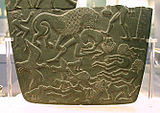Palette
In Egyptology and archeology, special art objects of different sizes and shapes with a flat body made of slate , porphyry or greywacke , the front and back of which could be decorated with coarse and simple or highly complex reliefs , are called splendid palettes or make-up palettes . The largest number of such pallets comes from the end of the Naqada III epoch (around 3,400–3,100 BC) and the beginning of the 1st dynasty . Productive sites are Naqada , Qustul and Abydos .

|

|

|

|
| Four-dog pallet | Hunter palette | Narmer palette | Battlefield Palette |
use
Ornamental pallets were coveted grave goods of the elite , but their popularity declined with the beginning of the 1st Dynasty, and the number of finds fell sharply under King Hor Aha ; the fragment of a palette from the tomb of King Hor Den is the latest known example.
The purpose of magnificent palettes is likely to be found in the cultic area. Presumably, make-up was made on them for ceremonial occasions by grinding certain pigments , obtained from minerals and ores , and mixing them with animal fats . For this reason, the term “make-up palette” is also common.
Well-known examples
Many splendid palettes have become widely known because of their relief representations:
literature
- David Wengrow: The archeology of early Egypt: social transformations in North-East Africa, 10,000 to 2,650 BC. Cambridge University Press, Cambridge 2006, ISBN 0-521-83586-0 .
- Toby Wilkinson : Early Dynastic Egypt. Routledge, London 1999, ISBN 0-415-26011-6 .
- Barry J. Kemp: Ancient Egypt: Anatomy of a civilization. 2nd edition, Routledge, London 2005, ISBN 0-415-23550-2 .
- Nicolas-Christophe Grimal : A history of ancient Egypt. Wiley-Blackwell, London 1996, ISBN 978-0-631-19396-8 .
